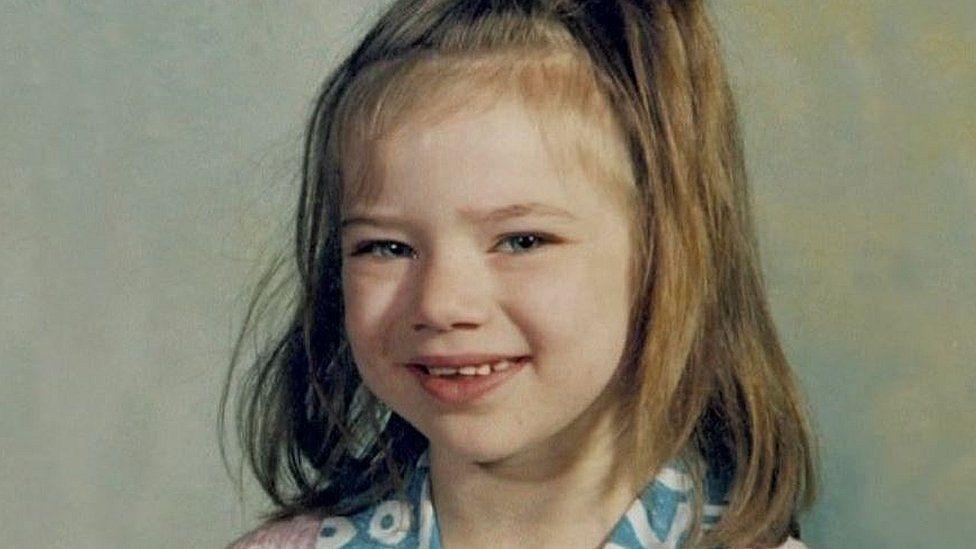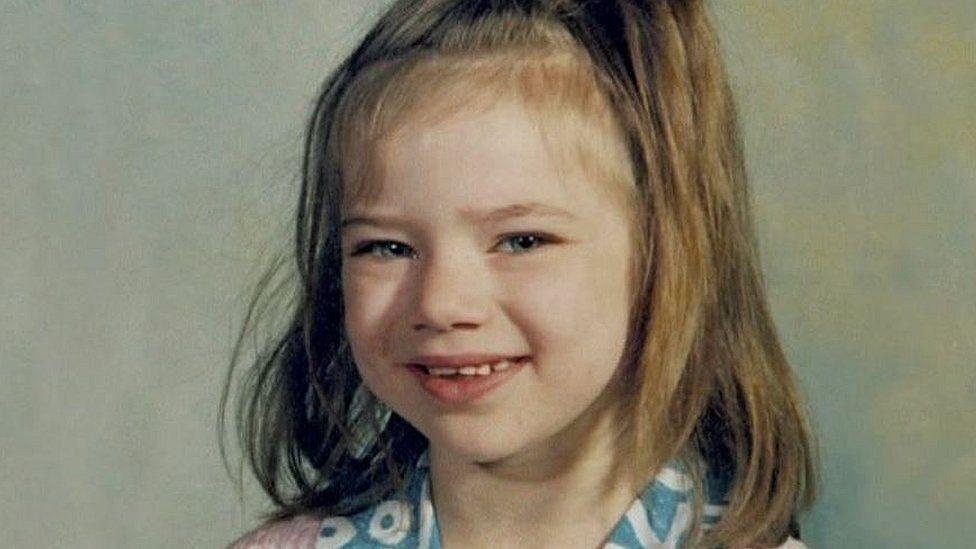Nikki Allan: David Boyd lured girl to her death in 1992, jury told
- Published

Nikki Allan went missing after leaving her grandparents' home in Sunderland in 1992
A man lured a seven-year-old girl away from her home and brutally murdered her more than 30 years ago, a jury has heard.
Nikki Allan's body was found with 37 stab wounds and other injuries in a derelict building in Sunderland in October 1992.
David Boyd, 55, of Chesterton Court, Stockton-on-Tees, denies murder.
Newcastle Crown Court heard he is the second man to be accused of killing Nikki.
George Heron was cleared of murder by jurors at Leeds Crown Court in 1993, and prosecutor Richard Wright KC said they were "right to do so".
'Skipping to her death'
In his opening statement, Mr Wright said Nikki was taken from outside the flats where she lived in Wear Garth, Sunderland, at 21:43 BST on 7 October 1992.
She was not abducted but rather "lured" as one witness reported seeing her "skipping" to catch up with a man, jurors heard.
"She was was unwittingly skipping towards her death," Mr Wright said.
Nikki was led to wasteland next to the River Wear where she was struck on the head, causing her to bleed.
The man then forced her through an opening in a boarded up window in the Old Exchange Building where he "beat her about the head with a brick" shattering her skull.
After that, she was repeatedly stabbed through her chest, heart and lungs.
A post-mortem examination found she had suffered "blunt force trauma" to the head that most likely knocked her unconscious before she was stabbed, Mr Wright said.
Witnesses heard screams at about 22:00 which "fixed the time of the killing", he said.
'Circumstantial but compelling'
Nikki's body was dumped in a basement room and discovered the next day by two volunteers who had joined the search for her.
Jurors were told the killer was David Boyd, who was 25 at the time and also known as David Smith or David Bell.
The case against the defendant was "circumstantial but compelling", as his DNA had since been found on Nikki's clothing, Mr Wright said.
Mr Boyd lived at Wear Garth on the same floor as Nikki's grandparents and was "well known to the family", the court was told, and his girlfriend was Nikki's babysitter.
Nikki lived with her mother, stepfather, sister and two half-sisters in a ground-floor flat, while the defendant lived on the third floor.
He "knew the layout" of the Old Exchange, the jury heard, and had told police he used the same window a few days before when he took a boy there to search for pigeons.
Mr Wright said the accused was of the "same age" and "bore a striking resemblance" to the man seen with Nikki.
'Only killer knows motive'
The jury heard he was the "last man" to tell police he saw Nikki alive at about 21:35 and created a false alibi for his whereabouts at 22:00.
"Bearing in mind at the time he made the lie, only the killer would have known at what time he had killed Nikki and would have appreciated [22:00] was an important time," Mr Wright said.
He said the prosecution did not have to prove a motive, adding: "Only the killer knows precisely why he did what he did to Nikki."
On the night she was killed, Nikki was seen playing with other children by the flats and also at 21:43 outside the Boar's Head pub.
Mr Wright said it was "not unusual" for children to be playing unsupervised outside when it was dark.
'No other candidate'
Mr Wright said modern DNA profiling techniques were hugely advanced from 1992 when the "science [was] in its infancy".
A profile matching Mr Boyd was found in four places on Nikki's clothing including the hip of her shorts and under the arm of her T-shirt.
The defendant was not Sunderland "born and bred" and had no family in the area, the jury heard.
Of the hundreds of other men tested, no other profile matched the DNA on the clothes.
Various factors pointed to Mr Boyd, the prosecution said, including that he "knew the girl" and murder site "well" and was a "dead-ringer" for an artist's impression of the man seen with Nikki.
"No other credible candidate for the murder who fits the wider criteria has been identified," Mr Wright said.
'Spitting off balcony'
Mr Wright said Mr Boyd was not considered a suspect in 1992 but was arrested in April 2018 on suspicion of murder following the DNA discoveries.
Jurors were shown video footage of his arrest at his home in which Mr Boyd said he had no involvement in the killing, but then asked: "What evidence have you got anyway?"
Mr Wright asked the jury to consider why he asked that and whether it might be the thoughts of someone who had got away with committing murder and now wanted to know what the police had to implicate him.
He said there were inconsistencies between his accounts of his movements that night and those of other witnesses, and when asked by police about the DNA on Nikki's clothing Mr Boyd said he had been spitting off his balcony that night and it may have hit Nikki.
When police said the DNA was on her clothes under her coat, Mr Boyd suggested Nikki may have wiped her hands in his spit and then smeared it on her clothes, the court heard.
The trial continues.

Follow BBC North East & Cumbria on Twitter, external, Facebook, external and Instagram, external. Send your story ideas to northeastandcumbria@bbc.co.uk, external.
Related topics
- Published20 June 2022
